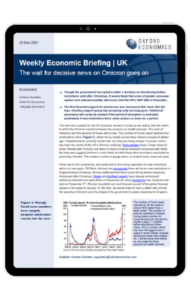The wait for decisive news in the UK on Omicron goes on

Though the government has opted to defer a decision on introducing further restrictions until after Christmas, it seems likely that a mix of greater consumer caution and reduced mobility will ensure that the UK’s GDP falls in December.
The first financial support for businesses was announced this week. But the days of policy support going big and going early are long gone.
What you will learn:
- Additional assistance will surely be needed if the period of disruption is extended, particularly if new restrictions force some sectors to close for a period.
- Hospitalisations currently remain low, but they are rising sharply in London, which has been the centre of the UK’s Omicron outbreak. Early studies show a lower share of those infected with Omicron are likely to require hospital treatment compared with Delta.
- The high case numbers have also brought widespread incidences of labour shortages. In response, the government has reduced the mandatory period of self-isolation for those testing positive from 10 days to seven, provided the infected person has returned two negative lateral flow tests, a change which should help at the margin.
Tags:
Related research

Post
Closing our short SEK trade to capitalise on the Scandi FX sell-off
We expected a bout of SEK weakness following the Riksbank rate cut in the spring, but we think the recent sell-off is overdone, and we close our long EURSEK trade, opened in May.
Find Out More
Post
US Industrial and retail outperform over the next five years
In our recent real estate webinar, we showed that prices started to turn a corner. We predict industrial and retail will record the smallest value declines this year, and over the next five years, apartment and industrial are expected to record the strongest value growth on average. Both sectors are expected to reach their peak values of 2022 this decade.
Find Out More